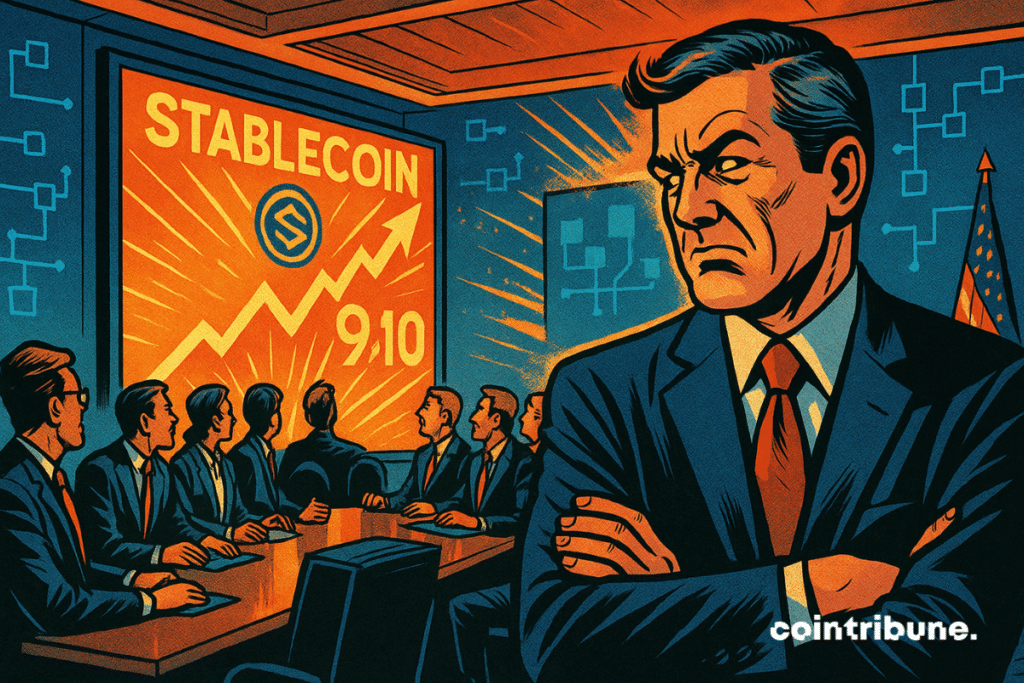Stablecoins: Why 9 Out Of 10 Banks Are Betting On This Financial Revolution
Stablecoins have paved their way at the crossroads of crypto and traditional finance. They embody a bridge between decentralized finance and classical institutions. Today, their adoption by banks continues to accelerate, signaling a profound change. This phenomenon is no longer limited to the crypto sphere but marks a major strategic evolution. Indeed, these digital assets are generating genuine institutional enthusiasm, shaping the new global financial architecture.

In Brief
- 90% of institutions adopt or test stablecoins to modernize their payments.
- Banks favor cross-border payments to reduce delays and inefficient costs.
- Settlement speed, cited by 48%, largely motivates this crypto adoption.
- Clear regulation and ready infrastructures facilitate the rise of stablecoins.
Banks’ Rush Toward Stablecoins: A Strategic Turn in Finance
For several years, banks had a cautious, even skeptical stance toward stablecoins. However, a recent report by Fireblocks reveals that 90% of financial institutions use or plan to use them. This shift is explained by the desire to avoid obsolescence in response to growing client demand.
Moreover, using stablecoins enables improving the speed and efficiency of payments, notably cross-border ones. Banks see these assets as an opportunity to modernize their aging infrastructures while remaining competitive against fintechs.
The survey, published in May 2025, questioned 295 executives from banks, fintechs, and payment providers. Among them, 49% already use stablecoins for payments, while 23% are testing their integration. These figures demonstrate very advanced adoption, especially in cross-border payments, where traditional systems struggle to meet expectations.
According to Fireblocks, this massive adoption reflects a strategic turn:
The race for stablecoins has become a matter of avoiding obsolescence as client demand accelerates and use cases mature.
Why This Crypto U-Turn? The Stakes Behind Banks’ Massive Adoption of Stablecoins
This turn reflects a double imperative. On one side, banks must meet rapidly changing client expectations. On the other, they face competitive pressure from fintechs and new crypto entrants. Stablecoins, being backed by fiat currencies, offer a clear advantage: their integration into existing treasury systems is simplified.
Thus, 58% of banks use stablecoins to accelerate international payments, a strategic feature in a globalization context.
Furthermore, speed of settlement is a key benefit, cited by 48% of respondents. This efficiency is essential to capture growing volumes of B2B transactions, especially in emerging markets. Additionally, transparency, better liquidity management, and reduced transaction costs enhance the attractiveness of stablecoins. Ran Goldi, senior vice president at Fireblocks, summarizes this trend:
Our research shows that 90% of companies are progressing in stablecoin implementation because they see it as a key growth lever.
Key Figures and Trends to Follow in the Stablecoin Revolution
The institutional adoption of stablecoins is reflected in impressive figures that mark a turning point in crypto finance. Here are some notable data points from the Fireblocks report:
- 90% of institutions have engaged in a stablecoin approach, usage or planning;
- 86% affirm their infrastructure is ready to move from pilots to large-scale adoption;
- 48% value settlement speed as the main advantage;
- 58% of banks already use stablecoins for cross-border payments;
- 9 out of 10 consider regulation and industry standards as adoption drivers.
This dynamic reflects a strategic movement where crypto reinvents itself at the very heart of financial services. Regions like Latin America, Asia, and Europe show differentiated but converging trajectories toward stablecoin integration. This phenomenon could reshape the global payments landscape, establishing crypto as an unavoidable pillar.
Could this shift in banks’ perception of stablecoins be linked to the rise of Donald Trump’s USD1 and Ripple’s RLUSD? These two players are now competing for shares in an increasingly competitive and regulated crypto market. Indeed, as institutions massively embrace stablecoins, the rivalry between these tokens symbolizes a battle to dominate the future of digital finance. Thus, this race is not only technological but also political and economic. It could well define the next era of crypto and banking.
Maximize your Cointribune experience with our "Read to Earn" program! For every article you read, earn points and access exclusive rewards. Sign up now and start earning benefits.
La révolution blockchain et crypto est en marche ! Et le jour où les impacts se feront ressentir sur l’économie la plus vulnérable de ce Monde, contre toute espérance, je dirai que j’y étais pour quelque chose
The views, thoughts, and opinions expressed in this article belong solely to the author, and should not be taken as investment advice. Do your own research before taking any investment decisions.